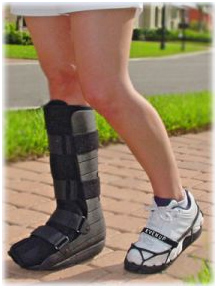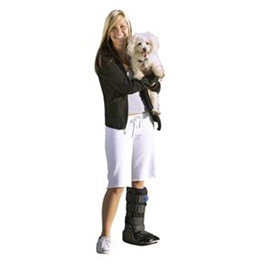If you are traveling and suffer form an injury in your ankle, foot or lower leg and do not want to get your leg casted, a Walking Boot may be a good solution to keep your injured leg mobile as often required when traveling and continue to best enjoy the ongoing vacation. This is one option for the traveler who may choose to off set the immediate cost of casting which may not be covered under local insurance and thus wait to be casted at home with their own health providers and physicians.
Orthopedic walking boots are used by people who have suffered a foot, ankle or lower leg injury. These boots are used on those with sprained ankles, soft tissue injuries, fractures or those recovering from foot or lower leg surgery. The boots provide support to the ankle and leg without inhibiting mobility. Orthopedic walking boots are a great option for those who want to keep their mobility and do not want their foot or lower leg casted. Once you learn how to strap up your boot, you will just need to practice walking.
Understanding if an Orthopedic Walking Boot is the right choice for the injured traveler
Orthopedic Walking boots are commonly recommended following ankle, foot and lower leg injuries. Injuries that can utilize a walking boot include ankle, foot and shin (tibia or fibula) fractures, ankle sprains, Achilles injuries or calf muscle tears.
Your doctor or physiotherapist will recommend a walking boot to you if they feel that this is the most appropriate treatment.
Why are Walking Boots Recommended?
Walking boots provide you with more mobility than a traditional cast. Many times a person who suffers an ankle, foot o lower leg injury will benefit from a walking boot. This walking boot is strapped to the affected leg and will help immobilize it in order for proper healing to occur. The intention of a walking boot is to keep you as mobile as possible, while still protecting the injured structure.
WALKING BOOT INSTRUCTIONS:
1 Pull a sock, very gently, up your foot. To ease any discomfort, scrunch your sock down and insert your toes into the toe part of the sock. Slowly un bunch the sock as you pull it up–like putting on tights or nylons. For foot and ankle injuries, you may need to tape your foot before putting on the sock.
2 Open the boot by detaching the Velcro straps. Most boots will have between two and five Velcro straps depending on your injury and the stability of your ankle. Hold the Velcro straps back with one hand so that the front of the boot is completely opened.
3 Sit down and place the walking boot behind your leg.
4 Slide your foot and ankle back into the open boot. Completely detaching and pulling back on the Velcro straps will help your foot slide into the boot without needing to bend your foot or ankle.
5 Release the Velcro straps from your hand. Thread the first Velcro strap (the strap closest to your toes) through the middle of the plastic threading bar on the other side of the boot. Then pull the strap over the bar and back to the other side. You should pull the strap tight enough to restrict foot and ankle movement but not too tight to restrict circulation.
6 Thread and tighten all of the Velcro straps, from the bottom up. Get up from your seated position slowly and practice walking in your boot. Instead of walking heel-toe, your foot will roll from your heel to your toe. Many orthopedic boots are rounded to help your foot roll better. Walk around your home and up and down your stairs until you feel confident walking in your boot.
7 Use a cane or one crutch for added support and to ease any pain. For foot, ankle and lower leg injuries, your cane or crutch should be on the side of your body opposite to your injury. For example, if you have broken your right foot, hold the cane in your left hand or place the crutch under your left armpit. Once you feel comfortable walking with your boot, you can discontinue cane or crutch use unless your doctor recommends you still use one.
These walking boots are now available at Essential Health Supplies in Aruba, a medical equipment and health supplies provider, located right across Aruba’s main Hospital and close to all resorts. They specialize in Home Health & Orthopedics and have a wide selection of Orthopedic Supports and Braces, mobility equipment such as walking aids, crutches, walkers etc. Essential also rents medical equipment such as wheelchairs, mobility scooters, bath chairs and can deliver directly to and from Hotel. Tel: 297-587-0940, info@essentialaruba.com, www.essentialaruba.com.






